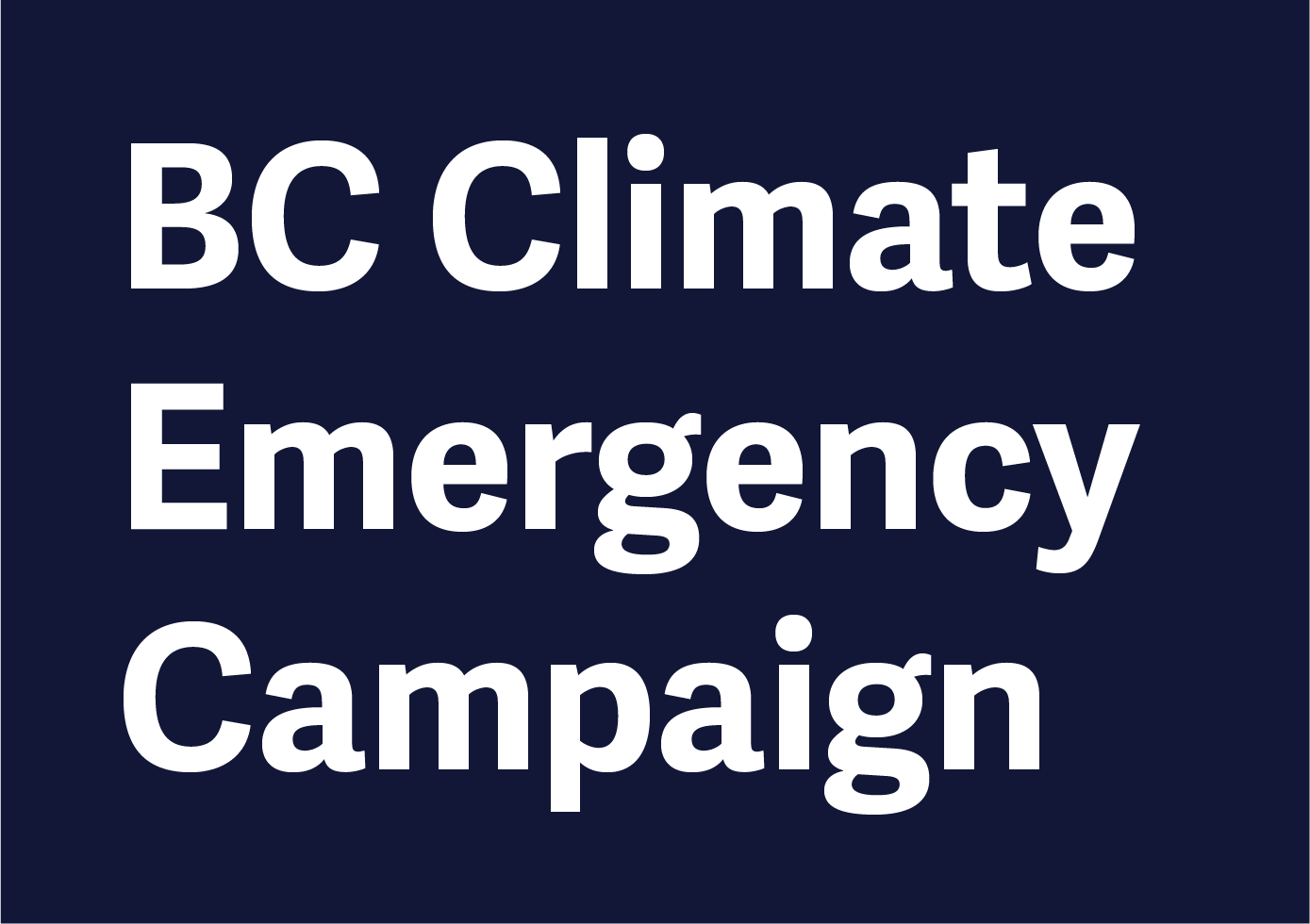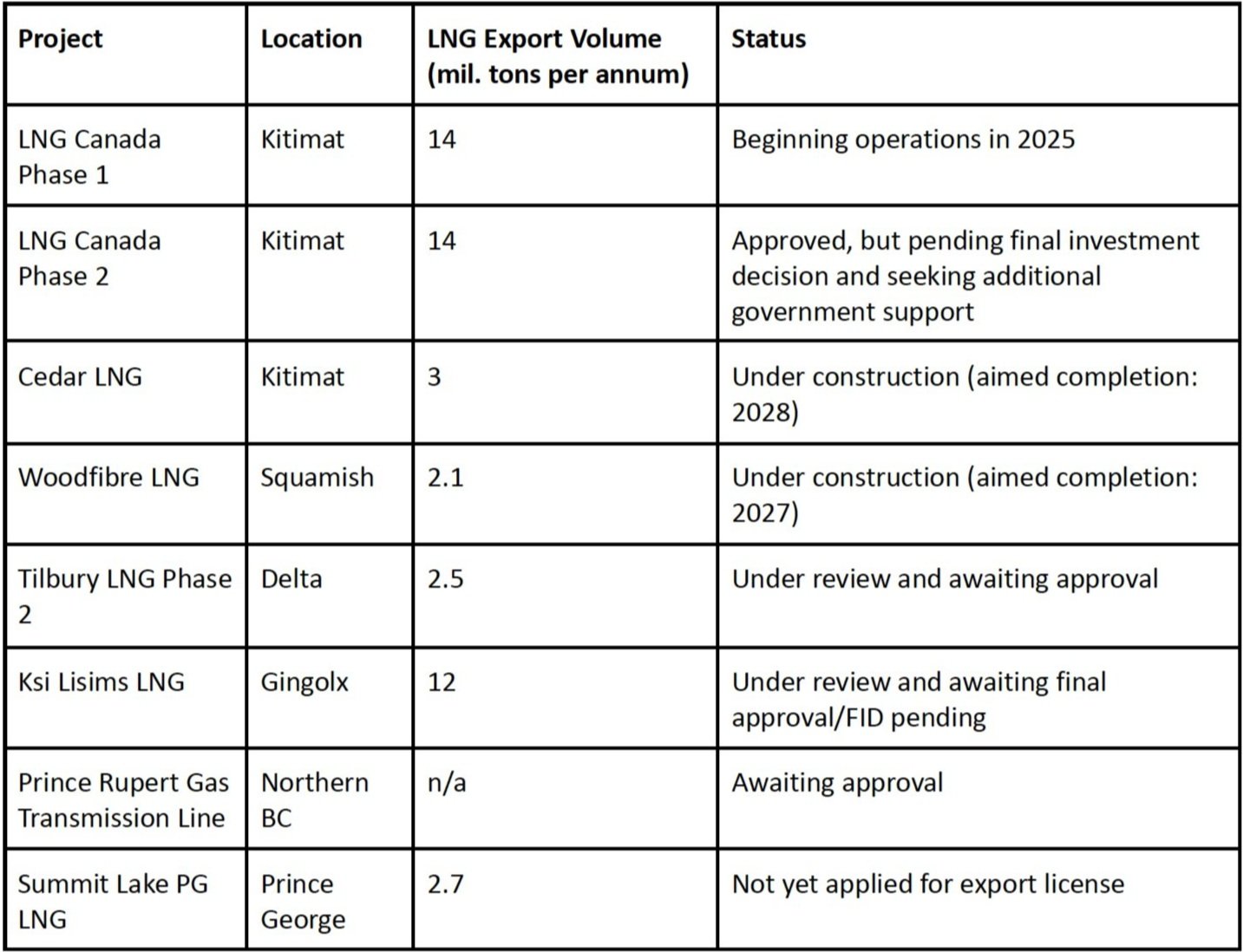Liquefied Natural Gas (LNG)
LNG has been widely promoted by governments and industry throughout B.C. as a fix-all solution that will supposedly boost B.C.’s economy, support local jobs, get countries in Asia off coal, reduce B.C.’s reliance on American energy exports, and lower B.C.’s emissions.
This briefing note, prepared by the BC Climate Emergency Campaign and allies, explains why LNG is a false solution on all these fronts.
OVERVIEW OF LNG PROJECTS IN BC
Last updated February 2025.
Environmental Concerns
-
LNG is primarily composed of methane, which traps 105 times more heat than CO2 over a 10-year span, which is the natural lifespan of methane in the atmosphere.
Fugitive methane emissions (leaks) all along the supply chain – from extraction, to processing, liquefaction, transporting, shipping, regasification, and combustion – are 50-90% above official reported figures. Considering methane’s potency, even small leakages have significant warming impacts.
New peer-reviewed research now indicates that, when considering this full life-cycle analysis, LNG has a carbon footprint that very often exceeds coal, sometimes by a considerable margin.
B.C. aims to reduce its greenhouse gas emissions by 21 megatons by 2030. If all of the above projects proceed, B.C.’s domestic emissions will increase by 13 megatons, making that target unattainable. More importantly, this does not count the downstream (“scope 3”) emissions from B.C.’s LNG exports. When that LNG reaches its destination and is burned, the above projects’ GHG emissions would be more than twice B.C.’s annual emissions. The downstream GHG emissions from either LNG Canada Phase 2 or the proposed Ksi Lisims project would – on their own – be equivalent to roughly half of B.C.’s total annual emissions.
-
Natural gas is obtained through fracking. As of the end of 2023, fracking in B.C. had used 9.7 billion litres of water per year. Estimates show that number increasing to 16 billion. The water used for fracking becomes so toxic that it cannot be reintroduced into the water cycle and must be held indefinitely in tailing ponds.
In addition to groundwater contamination caused from fracking, proposed LNG infrastructure will cause massive damage to local watersheds and salmon runs. If built, the Prince Rupert Gas Transmission pipeline would cut through some of the healthiest intact salmon watersheds left in B.C. which help feed thousands of families a year.
Fracking leads to earthquakes. In 2024 alone, the Montney formation (covering northeastern B.C. and northwestern Alberta) recorded 34 fracking-related earthquakes.
-
There is no guarantee that an emissions cap would result in no new LNG plants being constructed and a decline in gas production.
The cap only addresses production emissions; the vast majority of emissions occur when LNG reaches its intended market and is subsequently burned.
Electrifying LNG production could in fact be worse for the climate than using gas because it frees up gas that would otherwise be used for production and makes it available for export.
Health Concerns
-
There is increasing evidence fracking exposure leads to birth defects, asthma, respiratory illness, cardiovascular illness, childhood acute lymphocytic leukemia, and even death.
In B.C.’s Peace Region, where residents live in close proximity to fracking operations, doctors report staggering rates of glioblastoma and idiopathic pulmonary fibrosis in the local population.
On account of its health and environmental risks, fracking bans or moratoria have been enacted in Quebec, New Brunswick, Nova Scotia and Newfoundland and Labrador, as well as seven U.S. states and 11 countries.
If high pressure natural gas ships began docking and transferring cargo in the Howe Sound - English Bay area, and the Port of Richmond, this would present a massive health risk to local residents.
Economic Concerns
-
LNG in B.C. is being advanced by American investors, many of whom are closely allied with the Trump administration.
Texas-based Western LNG is a key player behind Ksi Lisims and the Prince Rupert Gas Transmission pipeline. Blackstone Inc., one of Western LNG's main investors, is run by Republican CEO Steve Schwarzman, who donated more than $39 million to the 2024 presidential race in support of Trump’s agenda and is a close advisor to President Trump.
B.C. should not be rewarding MAGA billionaires who are planning to take over BC LNG as part of their strategy to control critical resources in Canada. A large majority (80%) of Canadians oppose having American companies taking greater ownership of natural resource projects in Canada.
-
When local ratepayers have to compete with big exporters for a finite supply of either gas or electricity, the consequence is inevitably an increase in local gas and Hydro bills. Both the U.S. and Australia saw domestic gas prices increase once they began exporting LNG. At a time when British Columbians are already struggling to pay their bills, raising gas and electricity costs is not the answer. FortisBC bills have already started going up since January 2025.
In December, U.S. Department of Energy Secretary warned that “unfettered” LNG exports will raise U.S. domestic gas prices by 30%.
-
LNG Canada has received $6.5 billion in subsidies: this includes $5.34 billion in provincial subsidies, $275 million from the federal government, and a tariff exemption that will amount to $1 billion. These costs will rise further if more projects proceed.
-
It’s too late for Canada to jump on the LNG export train. Even optimistic timelines show proposed projects not beginning operations until the end of the decade, when predicted supply from current LNG producers is already expected to outpace demand. Trump’s recent lifting of Biden’s pause on LNG exports means supply will be increasing further. The U.S., Russia, and Qatar have significant projects under construction or seeking approval; B.C. simply cannot compete on cost against these other exporters. Qatar is by far the world’s lowest-cost LNG producer, which is unlikely to change.
Meanwhile, medium- and long-term natural gas demand forecasts are being consistently revised downward, while global renewable energy generation capacity is increasing far quicker than anticipated. By the end of this decade, projections are showing an oversupplied global LNG market.
Energy demand growth in key markets such as China is anticipated to slow relative to previous forecasts, with imports falling in places like Japan and South Korea.
Volatile LNG prices and construction delays are projected to continue reducing future demand.
-
Increasing evidence shows that new LNG facilities are diverting scarce financial and clean energy resources toward fossil fuel production and away from more cost-efficient decarbonization efforts. LNG is in fact crowding out investment in renewable energy, and therefore not leading to a decrease in global emissions by replacing coal consumption.
The 2024 U.S. Department of Energy report “shows a world in which additional U.S. LNG exports displace more renewables than coal globally.”
In 2024, the Ads Standards Council ruled that claims that B.C. LNG will reduce greenhouse gases globally is false advertising.
Switching from coal to gas power does little to change the overall trajectory of GHG emissions since increased supply (even when displacing coal) creates a long-term commitment to fossil fuel infrastructure, displaces investments in renewables and incentivizes additional consumption of gas. Canadian LNG, as additional supply, is superfluous and works against the needed energy transition. At the same time, renewables have matured, becoming reliable and cost-competitive.
LNG is not a “bridge fuel.” The climate crisis now requires that all jurisdictions leap straight to renewables.
-
All fossil fuel investments, including LNG investments, are subject to risks as energy systems change and the political terrain shifts. Unfavourable market conditions could create significant losses for BC’s LNG projects, leading to stranded assets. LNG expansion puts private investors, public taxpayers, Indigenous partners, workers, and local economies in an economically precarious position.
Increasing risks will likely lead to public expenditures and substantial government subsidies, borne largely by taxpayers. The Site C dam (whose cost ballooned to $16 billion) has already raised costs for BC Hydro consumers, worsening affordability concerns for British Columbians.
Impacts to First Nations
-
Indigenous consent issues associated with fossil fuel projects are complex. Economic hardship experienced by many Indigenous communities makes the appeal of such projects understandable. But in the context of poverty and unemployment, the degree to which consent is genuinely freely given is an open question.
Just because one nation supports a project does not mean surrounding nations do. While the Nisga’a Nation government supports Ksi Lisims LNG, the neighbouring Lax Kw’alaams Nation has never given their consent for the project (LNG tankers would pass through their territory). Gitanyow Hereditary Chiefs, whose salmon streams will be impacted, have also not consented.
Electrification Concerns
-
The rationale behind electrifying the cooling process is that the LNG can be labeled “clean” since carbon emissions were not released during the cooling process. However, if the gas used to convert natural gas into LNG is no longer needed for the cooling process, it will be exported instead and burned elsewhere. In other words, in overall atmospheric terms, there will be zero reduction in LNG’s carbon pollution. It might appear to be ‘clean’ on B.C.’s books, as Premier Eby stated in a Bloomberg interview in 2024, but this is irrelevant, since the urgent climate need is to reduce our global carbon pollution, with methane reductions being most important.
-
Electrifying gas production would require significant amounts of clean energy. If all proposed LNG facilities were to be electrified, they would require the equivalent of 8.4 Site C dams’ worth of capacity. This clean energy will necessarily have to be diverted from decarbonizing the rest of B.C.’s economy.
LNG expansion is an unfavourable decision for B.C.
Expanding our export capacity will lock in reliance on fossil fuel infrastructure for decades to come, render our climate targets unreachable, exacerbate the unnatural disasters already harming British Columbians, raise domestic gas prices once exporting begins, and accentuate health issues due to fossil gas extraction.
The B.C. government should not permit or financially support any further expansion of LNG.
Recommendation:
That the B.C. government does not permit or financially support any further expansion of LNG due to:
The cost to B.C. households in the form of higher gas and hydro bills;
A weak economic case in large part due to a glut of LNG global supply now and in the future;
The risks of stranded assets;
The close ties of President Trump and his allies to LNG projects in B.C.; and
A long list of major environmental, health and climate risks.

